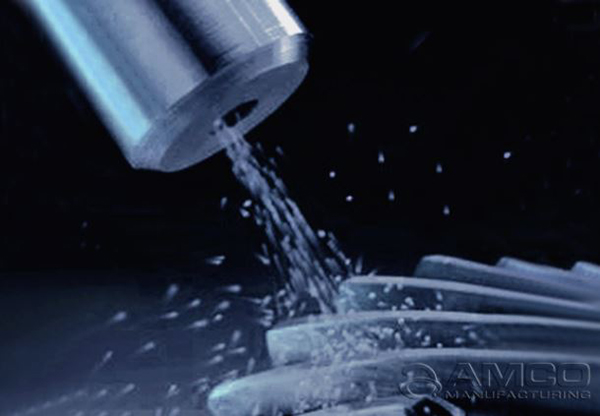Shot Peening

Shot peening is the process by which various small pieces of material, typically in the form of cast steel shot, cut wire, ceramic bead or glass bead are propelled onto and impact a material. When the media collides with the material, it creates a small dent. The dent causes the material immediately below to push back against the indent compressing the area of impact. When large number of adjacent indents are formed on the surface, a uniform residual compressive stress layer is created. This compressive layer works to counteract tensile forces on the material, resulting in an increase in fatigue life because of delayed crack propagation. Internal compressive stresses near the surface are balanced by tensile stresses deeper into the material. However, these deeper tensile stresses are not detrimental because cracks are unlikely to spread from the interior of a component.
Or put another way, shot peening is like squeezing the surface of the material together, so when a force that pulls on the material comes along, the squeezing counteracts the pulling. Imagine a component that is continuously cyclically stressed. Over time, microcracks that are present on the surface begin to spread and if the number of cycles and loads are large enough, the cracks will spread perpendicular to the applied tensile stress. The compressive stress induced by shot peening keeps the cracks from propagating and increases the fatigue life of the component.
Application Methods
The two main ways media is shot at material are air blast and centrifugal wheels. Air blast is fairly self explanatory; the pellets are moved thru a hose via pressured air and released onto the surface. Centrifugal wheels, meanwhile, load up shot in its’ paddles and then release once up to speed similar to a shot put. Both methods often utilize an enclosed sheet metal cabinet or even walk in container, with a closed loop system recycling the shot in both cases. Shot peening in the field, outside of a manufacturing facility can also be performed where the media is not automatically reused, however clean up and its’ associated costs typically restrict these applications to very large assemblies which are not readily moveable and other options do not exist.
Component Applications
There are many applications where it is practical to apply shot peening to extend fatigue life of components and to reduce stress corrosion cracking. Often shot peening is applied over areas of stress risers, where abrupt changes in geometry cause stress to concentrate and are a common location of failure. Examples of stress risers are holes, internal corners, grooves, and thread roots. Component application examples for shot peening include gears, springs, shafts, connecting rods, crankshafts, and turbine blades.
Peen forming
The compressive stresses imparted onto the surface of material can also be used as a forming method. For example, large panels can be shaped without expensive dies or presses due to the stretching of the outer surface which causes the panels to bend towards the shot stream. Peening forming can also be used to straighten shafts or components that are bowed.